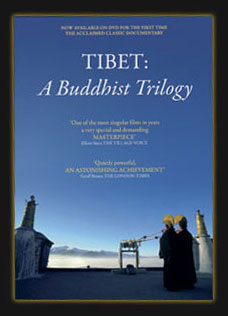Tibet: A Buddhist Trilogy: Difference between revisions
Naomigassler (talk | contribs) No edit summary |
Naomigassler (talk | contribs) No edit summary |
||
| Line 1: | Line 1: | ||
[[Image:TibetABuddhist_TrilogyDVDcover.jpg|frame|Cover of the DVD release of the trilogy in 2006.]] | |||
'''Tibet: A Buddhist Trilogy''' is a trilogy directed and written by Graham Coleman, and produced by David Lascelles, the 8th Earl of Harewood, released in cinemas in 1979. | '''Tibet: A Buddhist Trilogy''' is a trilogy directed and written by Graham Coleman, and produced by David Lascelles, the 8th Earl of Harewood, released in cinemas in 1979. | ||
Revision as of 13:27, 1 April 2021

Tibet: A Buddhist Trilogy is a trilogy directed and written by Graham Coleman, and produced by David Lascelles, the 8th Earl of Harewood, released in cinemas in 1979.
The production of the film was greatly helped by Sogyal Rinpoche who, towards the end of 1975, travelled with the film makers to the Indian subcontinent and connected them with all main lineage holders of Tibetan buddhism in exile, including Dudjom Rinpoche, Sakya Trizin and the 15th Gyalwa Karmapa, Karmapa Rangjung Rigpé Dorje.
David Coleman started studying buddhism with Sogyal Rinpoche in 1975 in his first dharma centre called Urgyen Chöling in Chatsworth Road, Kilburn, London. When the film was released in the US, Sogyal Rinpoche travelled there with the filmmakers and presented the trilogy in theatres across the country. This promotional tour established Rinpoche as an expert in the topic of Buddhism and Death and Dying in the US, and was the start for his teaching career in the US.
The film consists of three parts
Part I: The Dalai Lama, the Monasteries and the People
Filmed in the Dalai Lama’s residence in Dharamsala, North India, and in the re-built Sera Monastery, the second largest monastery of the old Tibet, this opening part of the Trilogy observes the Dalai Lama in his dual role as political leader and spiritual teacher. In an elegant cinematic style, at one with its subject, the film interweaves this personal portrait with an intimately observed exploration of the ways in which the inner knowledge of Tibetan Buddhist culture is developed in the monasteries, through vigorous debate and solitary meditation, and communicated in to the lay community.
Part II: Radiating the Fruit of Truth
With extraordinary authenticity Part II of the Trilogy journeys deep into the mystical inner world of monastic life. Set in the ancient village of Boudha, Nepal and the isolated mountain caves of the yogis, the film follows the lamas of the Phulwary Sakya Monastery through their contemplative retreats, the building of an intricate cosmogram, and the performance of an ancient protective ritual known as ‘A Beautiful Ornament’. Through the ritual invocation of the female deity Tara, the malevolent forces that might bring harm to the society are invited and magically transformed. With a subtitled commentary based on the teachings of the great 20th century master Dudjom Rinpoche, the essence of tantric Buddhism is powerfully revealed.
Part III: The Fields of the Senses
Set in the majestic mountain landscape of Ladakh, Part III is a meditation on impermanence and the relationship between the mind, body and environment. It follows the monks and farmers through a day, ending with an unflinching depiction of the monastery's moving ritual response to a death in the community. As in the Tibetan Book of the Dead, the departed is guided through the dream-like intermediate state between death and birth.